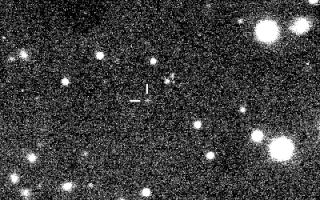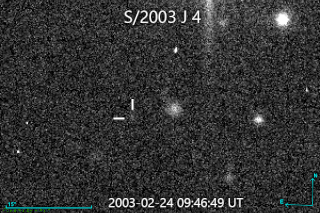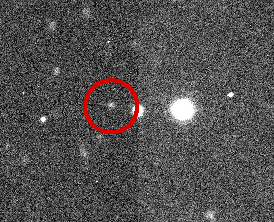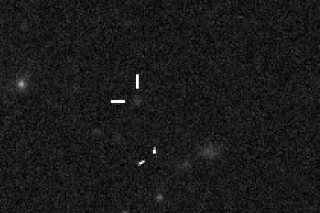Related Research Articles

Callirrhoe (; Greek: Καλλιρρόη), also known as Jupiter XVII, is one of Jupiter's outer natural satellites. It is an irregular moon that orbits in a retrograde direction. Callirrhoe was imaged by Spacewatch at Kitt Peak National Observatory from October 6 through November 4, 1999, and originally designated as asteroid 1999 UX18. It was discovered to be in orbit around Jupiter by Tim Spahr on July 18, 2000, and then given the designation S/1999 J 1. It was the 17th confirmed moon of Jupiter.

Kale, also known as Jupiter XXXVII, is a retrograde irregular satellite of Jupiter. It was discovered in 2001 by astronomers Scott S. Sheppard, D. Jewitt, and J. Kleyna, and was originally designated as S/2001 J 8.

Orthosie, also known as Jupiter XXXV, is a natural satellite of Jupiter. It was discovered by a team of astronomers from the University of Hawaii led by Scott S. Sheppard in 2001, and given the temporary designation S/2001 J 9.

Pasithee, also known as Jupiter XXXVIII, is a retrograde irregular satellite of Jupiter. It was discovered by a team of astronomers from the University of Hawaii led by Scott S. Sheppard in 2001, and given the temporary designation S/2001 J 6.

S/2003 J 2 is a retrograde irregular satellite of Jupiter. The moon was discovered on 5 February 2003 by a team of astronomers from the University of Hawaii led by Scott S. Sheppard and David C. Jewitt, and was later announced on 4 March 2003. It was initially thought to be Jupiter's outermost known moon until recovery observations disproved this in 2020.

S/2003 J 4 is a natural satellite of Jupiter. It was discovered by a team of astronomers from the University of Hawaii led by Scott S. Sheppard in 2003.

S/2003 J 9 is a retrograde irregular satellite of Jupiter. It was discovered by a team of astronomers from the University of Hawaii led by Scott S. Sheppard in 2003.

S/2003 J 12 is a natural satellite of Jupiter, and is one of the smallest known natural satellites in the Solar System. It was discovered by a team of astronomers from the University of Hawaii led by Scott S. Sheppard in 2003.

S/2003 J 23 is a natural satellite of Jupiter. It was discovered by a team of astronomers from the University of Hawaii led by Scott S. Sheppard et al. in 2004 from pictures taken in 2003.
Jupiter LIV, originally known as S/2016 J 1, is an outer natural satellite of Jupiter. It was discovered by Scott S. Sheppard in 2016, but not announced until June 2, 2017 via a Minor Planet Electronic Circular from the Minor Planet Center. It is about 1 kilometer in diameter and orbits at a semi-major axis of about 20,650,845 km with an inclination of about 139.8°. It belongs to the Ananke group.

Jupiter LIX, provisionally known as S/2017 J 1, is an outer natural satellite of Jupiter on a retrograde orbit. It was reported on June 5, 2017 via a Minor Planet Electronic Circular from the Minor Planet Center. It is believed to be about 2 km in diameter.

Valetudo, also known as Jupiter LXII and originally known as S/2016 J 2, is a moon of Jupiter. It was discovered by Scott S. Sheppard and his team in data acquired by the 6.5-m Magellan-Baade telescope of the Las Campanas Observatory in 2016, but was not announced until 17 July 2018, via a Minor Planet Electronic Circular from the Minor Planet Center, which also reported the discovery of nine other Jupiter moons. Besides data from Las Campanas, the original announcement also referred to data acquired through the 8.1-m Gemini North telescope — of the Mauna Kea Observatories — as well as the 4.0-m reflector of the Cerro Tololo Inter-American Observatory.
Jupiter LXIII, provisionally known as S/2017 J 2, is an outer natural satellite of Jupiter. It was discovered by Scott S. Sheppard and his team in 2017, but not announced until July 17, 2018 via a Minor Planet Electronic Circular from the Minor Planet Center. It is about 2 kilometers in diameter and orbits at a semi-major axis of about 23,303,000 km with an inclination of about 166.4°. It belongs to the Carme group.
Jupiter LXIV, originally known as S/2017 J 3, is an outer natural satellite of Jupiter. It was discovered by Scott S. Sheppard and his team in 2017, but not announced until July 17, 2018 via a Minor Planet Electronic Circular from the Minor Planet Center. It is about 2 kilometers in diameter and orbits at a semi-major axis of about 20,694,000 km with an inclination of about 147.9°. It belongs to the Ananke group.
Ersa, also Jupiter LXXI, originally known as S/2018 J 1, is an outer natural satellite of Jupiter. It was discovered by Scott S. Sheppard and his team on 11 May 2018, and was later announced on 17 July 2018, via a Minor Planet Electronic Circular from the Minor Planet Center. It is about 3 kilometres (2 mi) in diameter and has an orbit radius of around 11,483,000 kilometres ; its orbital inclination is about 30.61°. It belongs to the Himalia group.
Pandia, also known as Jupiter LXV, originally known as S/2017 J 4, is an outer natural satellite of Jupiter, 3 km in diameter.
Jupiter LXVI, originally known as S/2017 J 5, is an outer natural satellite of Jupiter. It was discovered by Scott S. Sheppard and his team in 2017, but not announced until July 17, 2018 via a Minor Planet Electronic Circular from the Minor Planet Center. It is about 2 kilometers in diameter and orbits at a semi-major axis of about 23,232,000 km with an inclination of about 164.3°. It belongs to the Carme group.
Jupiter LXVIII, provisionally known as S/2017 J 7, is an outer natural satellite of Jupiter. It was discovered by Scott S. Sheppard and his team in 2017, but not announced until July 17, 2018, via a Minor Planet Electronic Circular from the Minor Planet Center. It is about 2 kilometers in diameter and orbits at a semi-major axis of about 20,627,000 km with an inclination of about 143.4°. It belongs to the Ananke group.
Jupiter LXX, originally known as S/2017 J 9, is an outer natural satellite of Jupiter. It was discovered by Scott S. Sheppard and his team in 2017, but not announced until July 17, 2018, via a Minor Planet Electronic Circular from the Minor Planet Center. It is about 3 kilometers in diameter and orbits at a semi-major axis of about 21,487,000 km with an inclination of about 152.7°. It belongs to the Ananke group.

Jupiter LXIX, originally known as S/2017 J 8, is an outer natural satellite of Jupiter. It was discovered by Scott S. Sheppard and his team in 2017, but not announced until July 17, 2018, via a Minor Planet Electronic Circular from the Minor Planet Center. It is about 1 kilometer in diameter and orbits at a semi-major axis of about 23,232,700 km with an inclination of about 164.7°. It belongs to the Carme group.
References
- ↑ S.S. Sheppard (2019), Moons of Jupiter, Carnegie Science, on line
- ↑ "MPEC 2018-O14 : S/2017 J 6". Minor Planet Center. International Astronomical Union . Retrieved 17 July 2018.
- ↑ "Archived copy". Archived from the original on 2017-07-20. Retrieved 2018-07-17.CS1 maint: archived copy as title (link)